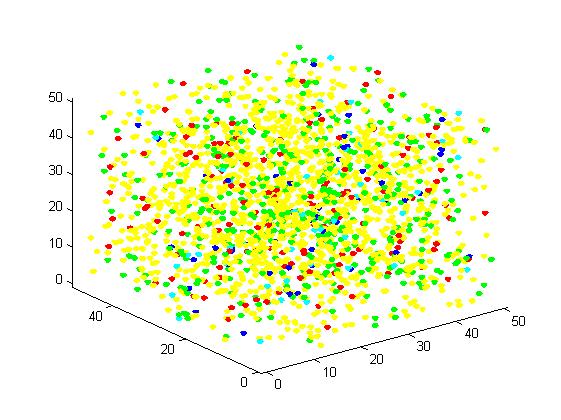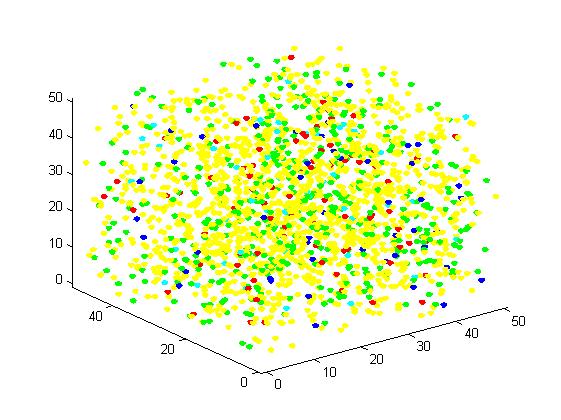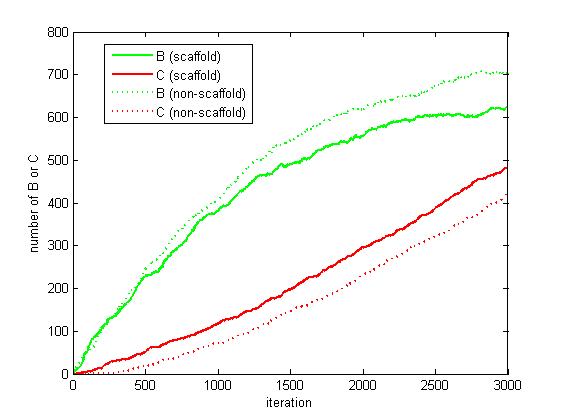Team:ZJU-China/model s2 3.htm
From 2012.igem.org
| Line 281: | Line 281: | ||
<p align="justify">As the iteration increasing, the number of A is decreasing and the number of B and C are increasing. We record the number of B and C for both scaffold system and non-scaffold system as iteration grows to watch the reaction rate of pathway (i.e. the number of C).</p> | <p align="justify">As the iteration increasing, the number of A is decreasing and the number of B and C are increasing. We record the number of B and C for both scaffold system and non-scaffold system as iteration grows to watch the reaction rate of pathway (i.e. the number of C).</p> | ||
<div class="floatC"><img src="http://www.jiajunlu.com/igem/zju_model2_6.jpg" width="400px"> | <div class="floatC"><img src="http://www.jiajunlu.com/igem/zju_model2_6.jpg" width="400px"> | ||
| - | <p class="fig | + | <p class="fig"><b>Fig 6.</b> The number of B and C as iteration grows.</p> |
| + | </div> | ||
<p align="justify"> </p> | <p align="justify"> </p> | ||
<p align="justify">From figure 4.5.6, it is obvious that the number of C for scaffold system is more than that for non-scaffold system and the number of B for scaffold system is less than that for non-scaffold system. This phenomenon can be interpreted as that the probability that B meets an E2 is highly increased since their distance is closer. Therefore, it is safely to draw a conclusion that the reaction rate of pathway has been speed up because of the scaffold bringing two enzymes closer.</p> | <p align="justify">From figure 4.5.6, it is obvious that the number of C for scaffold system is more than that for non-scaffold system and the number of B for scaffold system is less than that for non-scaffold system. This phenomenon can be interpreted as that the probability that B meets an E2 is highly increased since their distance is closer. Therefore, it is safely to draw a conclusion that the reaction rate of pathway has been speed up because of the scaffold bringing two enzymes closer.</p> | ||
Revision as of 15:23, 25 October 2012
A large scale simulation
The initial state is as following:
Edge of cube: 50 units
The amount of A: 2000
The amount of B: 0
The amount of C: 0
The amount of E1: 50
The amount of E2: 50
The distance between E1 and E2 for RNA scaffold: 2 units
After 1200 iterations, the scaffold and non-scaffold results are as following:
| Scaffold | Non-scaffold | |
|---|---|---|
| A (Substrate) | 1417 | 1470 |
| B (Intermediate) | 436 | 451 |
| C (Product) | 147 | 79 |
| E1 (Enzyme1) | 50 | 50 |
| E2 (Enzyme2) | 50 | 50 |

Fig 4. Result of scaffold system for large scale simulation. After 1200 iterations, there are 436 B and 147 C.

Fig 5. Result of non-scaffold system for large scale simulation. After 1200 iterations, there are 451 B and 79 C.
Comparison between the two system
As the iteration increasing, the number of A is decreasing and the number of B and C are increasing. We record the number of B and C for both scaffold system and non-scaffold system as iteration grows to watch the reaction rate of pathway (i.e. the number of C).

Fig 6. The number of B and C as iteration grows.
From figure 4.5.6, it is obvious that the number of C for scaffold system is more than that for non-scaffold system and the number of B for scaffold system is less than that for non-scaffold system. This phenomenon can be interpreted as that the probability that B meets an E2 is highly increased since their distance is closer. Therefore, it is safely to draw a conclusion that the reaction rate of pathway has been speed up because of the scaffold bringing two enzymes closer.
 "
"